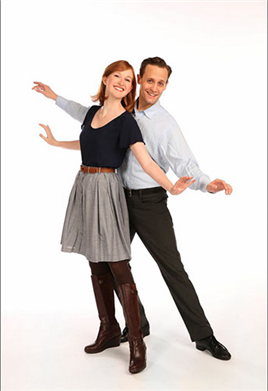By LAUREN KAY
The most famous song and dance men---the Fred Astaires and Gene Kellys---are synonymous with debonair style, majestic movement, and a surplus of charm. And while the ranks of these elegant performers may have dwindled as tastes have changed, those nostalgic for swift-footed dancing and perfectly harmonized Gershwin tunes can enjoy the Encores! Presentation of Lady, Be Good at New York City Center from February 4 to 8.
The 1924 musical, originally starring Fred and Adele Astaire, follows a poor brother and sister who crash a party in the hopes of marrying for money. The current incarnation, which uses the Encores! model of presenting lightly staged readings of classic shows, offers not only well-known hits like "Fascinating Rhythm," but also a performance by Tommy Tune.
And in the lead role there's Danny Gardner, who's staking his claim as an heir to the "song and dance man" crown.
He's arguably been heading toward this title for his entire career. The Reading, PA, native started his tap dance training at age 5, studying a grounded hoofing style. However, his first job after graduating from Ithaca College was a tour of 42nd Street, a show that uses the lighter, pulled-up Broadway tap style. The experience helped solidify his appreciation for the genre, shedding light on his future path.
"I was always in love with Fred and Gene," Gardner says. "Many times I'd watch movies of Fred, trying to learn his steps. I even got a mirror and tried to pull the choreography without it being backward. And on the tour, I found that that style of Broadway tap felt so right on my body. It was fun, in that I was on the toes and balls of my feet versus back in my heels as in hoofing. I felt exciting and light, like I could dance more with the music."
He adds, "I love the specificity of the style: where you're looking, the angle of the head, the carriage, the line of the arms. You can feel it when it's right."
About two years ago, he ramped up his research on his forebears. "I decided to immerse myself in Fred and Gene," he says. "Every night I'd throw on a Fred Astaire movie. I knew I was going down this path, and I had seen movies but could always see more. Over time, I noticed there are characteristics of both that I've started embodying: Gene, to me, had such a groundedness. For example, he does this thing with his shoulders when he raises them and tilts his head. It looks like he feels so good when he's dancing, and I noticed I've taken that on because I want to feel that way too. Fred has a sharpness to his movement: He is so light, and that taught me there's no need to get heavy on my feet."
Despite this background, though, Gardner didn't feel he had to replicate Astaire's physical performance in <em>Lady, Be Good</em>. Nor did listening to songs sung by Fred and Adele dictate his vocal approach.
"In one of our first vocal rehearsals, the music director said, 'You're singing with Fred's rhythm, and that's fine, but let's look at the actual rhythm on the page and then you can decide which you like,'" Gardner recalls. "They're being true to the Gershwins <em>and</em> the Astaires."
Gardner also relies on the Encores! model to keep him on stylistic track without getting stuck in caricature. "Encores! is so specific and authentic to the way each show was done originally," he says. "They spent so much time and energy reconstructing the orchestrations and what that would have really been like. You can hear that in the music. Every note is chosen carefully, and in music rehearsals we've talked about why a specific note has been chosen and what the manuscripts say."
In addition, choreographer Randy Skinner and director Mark Brokaw provide steady hands for his process. "They have such an eye for that style," Gardner says. "For example, Randy can tell specific stories, explaining, 'Oh, they used their hands like this, not that way,' and so I can rely on them to guide me. I can offer what I know from my personal studies, and Randy sculpts me. I learned from Randy that it's not just about the sounds or steps. You need to dance through it---just like Fred did."
---
Lauren Kay is a writer and dancer based in New York
